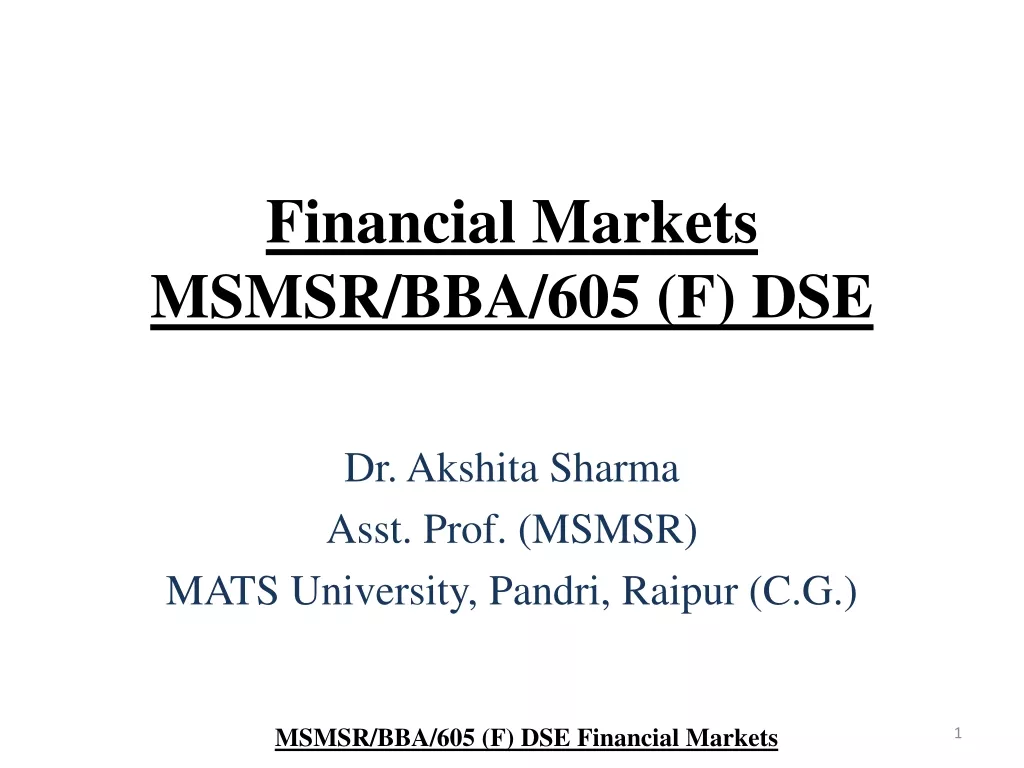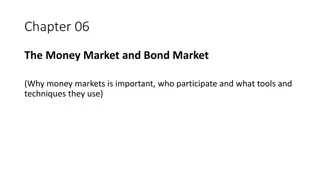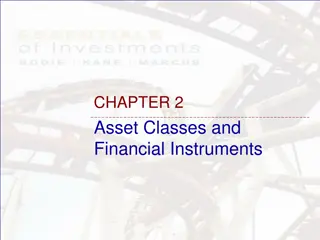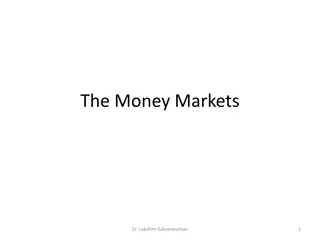Overview of Chinese Equity Markets: History and Regulation
Explore the evolution of Chinese stock markets from their beginnings in the centrally planned economy to the establishment of the Shanghai and Shenzhen stock exchanges in the 1990s. Learn about the regulatory framework, rights of stockholders, agency problems, and the role of the state in Chinese listed firms. Discover key factors influencing stock returns and the nature of stock exchanges in China.
Download Presentation

Please find below an Image/Link to download the presentation.
The content on the website is provided AS IS for your information and personal use only. It may not be sold, licensed, or shared on other websites without obtaining consent from the author.If you encounter any issues during the download, it is possible that the publisher has removed the file from their server.
You are allowed to download the files provided on this website for personal or commercial use, subject to the condition that they are used lawfully. All files are the property of their respective owners.
The content on the website is provided AS IS for your information and personal use only. It may not be sold, licensed, or shared on other websites without obtaining consent from the author.
E N D
Presentation Transcript
EQUITY MARKETS THE CHINESE FINANCIAL SYSTEM, SPRING 2014 PV VISWANATH LUBIN SCHOOL OF BUSINESS P.V. Viswanath
LEARNING OBJECTIVES How did the Chinese stock markets begin? What is the legal framework within which the stock markets operate? What sorts of rights and protection do stockholders have in China? How has this developed over time and what have been the factors influencing change? What is the role of the state as a shareholder? What is the nature of agency problems in Chinese listed firms? Who are the Chinese shareholders? What is the nature of stock returns in China? P.V. Viswanath 2
HISTORY OF THE EXCHANGES From 1949 to 1979, China was a centrally planned economy where virtually all enterprises were state owned or collectively owned. Stock markets were viewed as a symbol of capitalism and the last stock exchange was shut down in February 1952, in the year that the Central Planning Commission was established. In the mid-1980s, some local governments took over control and cash flow rights of many small-and medium-sized collectively owned enterprises. These governments then experimented with selling the stocks of these enterprises directly to domestic individual investors to raise funds to finance the enterprises. Curb trading of enterprise stocks soon began as was quickly followed by over-the- counter trading in more organized by informal exchanges. P.V. Viswanath 3
HISTORY OF THE STOCK EXCHANGES The Shanghai (SHSE; under the aegis of the Shanghai municipal government) and Shenzhen (SZSE; established by the Shenzhen municipal government) stock exchanges were (re)established in December 1990 and April 1991, respectively. The Shanghai Stock Exchange focuses on large corporations. In Dec. 2010, there were 892 companies listed with a total market capitalization of 17.9Tr. . The SZSE has large firms, but also SMEs. It set up a SME Board market in May 2004 and the ChiNext market in 2009, which targets innovative growth enterprises with prospects of future profit. The SME Board market is intended to serve firms in a relatively mature stage of development stable profitability. In Dec 2010, there were 1169 firms listed (485 on the main board, 531 on the SME Board market and 153 on the ChiNext market with a total capitalization of 8.64Tr. . In Dec. 2010, there were a total of 894 firms listed on the SHSE with a total market capitalization of 17.9Tr. . In comparison, there were 1867 companies listed on the NYSE in April 2014 with a total market capitalization of $16.6Tr, i.e. approximately about six times that of the SHSE. P.V. Viswanath 4
REGULATION Prior to the creation of the two national stock exchanges, the PBOC acted as China s securities market regulator. At the beginning, the PBOC delegated its authority over the regulation of the stock market to its local branches. The earliest regulations over the issuance of stocks were therefore promulgated by the PBOC s local branches in Shanghai, Beijing, Guangdong and Xiamen SEZ. In the beginning, the primary concern of these regulations was to make it clear who had the rights to issue and buy stock. In order to ensure that capital flowed to SOEs, early regulations in May 1990 restricted stock issuance to SOEs. Then in order to ensure that stock trading did not dilute state ownership and state control over SOEs, in May 1992, a regulation created three different types of shares: State shares (owned by a representative of the state, often the relevant state-owned assets bureau); and legal person shares (owned by large institutions, often affiliated with the state), which can be transferred/traded only with administrative approval. A-shares, which are yuan-denominated and are available for trading by domestic shareholders on the domestic stock exchanges. B-shares, which are available for trading by foreign investors in foreign currencies on the domestic stock exchanges. (Since 2001, domestic investors can also buy these, albeit with foreign currency.) Later, H or N-shares were created, which are listed on the Hong Kong or New York exchanges. Chinese citizens cannot invest in these stocks because capital market convertibility of the RMB still doesn t exist. The objective was to authorize stock issuance as a legitimate means of fund-raising, but to restrict this to SOEs. P.V. Viswanath 5
LEGAL FRAMEWORK At this stage, there were no regulations aimed at keeping the market transparent and fair. In August 1992, a riot broke out in Shenzhen, with about a million investors suspecting official corruption. In response, in October 1992, the government established the State Council Securities Commission (SCSC) and an executive arm, the China Securities Regulatory Commission (CSRC). (Note: all of this followed Deng XiaoPing s Southern Tour in Jan-Feb 1992.) In 1993, regulations were issued which detailed different kinds of securities fraud, including insider trading, market manipulation and false information disclosure. However, penalties for such actions were limited to fines and administrative sanctions, but there were no civil remedies for individual shareholders. Originally, SOEs were only accumulations of assets, entirely "owned by the State on behalf of all the people," with no independent legal personality. In 1986, a civil code stipulated that SOEs could acquire legal personality and the 1986 Bankruptcy code specified that these SOEs would assume civil liability to the extent of the assets given to them to manage on behalf of the people. The 1994 Company Law allowed the creation of joint stock limited liability companies. Under this law, private shareholders were given the right to seek compensation for damages due to information misrepresentation and market manipulation. Directors, managers, and supervisors were required to protect the interest and benefits of the company with loyalty and honesty. However shareholders could not sue them. In April 1998, the CSRC, which became the sole regulator of China s securities and futures markets by combining the activities of the SCSC and the PBOC. The Securities Law, which became effective in July 1999 gave the power to the government to impose criminal and administrative penalties on wrongdoers. However, there were still no civil remedies. P.V. Viswanath 6
LEGAL FRAMEWORK In 2001, the CSRC commenced a series of investigations into irregularities and illegitimate activities in the stock market. Private investors, however, were not satisfied and tried to take listed firms to the courts, themselves. In September 2001, the Supreme People s Court issued a ban on such private shareholder lawsuits; however, this ban was lifted in early 2002. Finally in 2003, the SPC issued rules allowing shareholders to launch collective civil suits in which a number of plaintiffs could jointly sue a listed company. However, for various reasons, in practice it was still difficult to sue companies. A new Company Law and Securities Law became effective on January 1, 2006, which provided expanded rights to shareholders and established civil liabilities for false corporate disclosure, and for insider trading and market manipulations. However, there are some problems with the rights provided under the legislation. For example, it is the company that is stated as being defrauded by these illegal actions. Hence the officeholders of the company would have to represent the company in any legal action. Unfortunately, it is often these same people who are the perpetrators of the illegal actions! However, a shareholder may apply to the court to have a company resolution rescinded if it violates the provisions of laws or administrative regulations. P.V. Viswanath 7
COMPANY LAW OF 2006 Under the new Company Law (Article 148), for the first time, directors and senior management personnel owe a duty of loyalty and duty of care and diligence to the company. In particular, they are not allowed to: Misappropriate company funds Deposit company funds in a bank account opened in their names or in the name of others Use company funds to make loans to others or provide guarantee for others Enter into contracts with the company or carry out transactions with the company in violation of the provisions of the articles of association of the company without the consent of shareholders Divert commercial opportunities to themselves or others while carrying out their duties Pocket the commission for transactions between the company and other parties Disclose company secrets Use their position to take bribes or other illegal income. Of course, as mentioned above, implementing these rules might be quite challenging. Furthermore, any damages recovered will belong to the company. Under what circumstances the shareholders will be able to recover legal costs is not provided in his Law. Ling, Shum and Wong, The Emergence of Shareholder Protection in China, in James Barth, John A. Tatom and Glenn Yago (eds.) China s Emerging Financial markets: Challenges and Opportunities, New York: Springer, 2009 P.V. Viswanath 8
IMPROVING SHAREHOLDER PROTECTION From the above description, it is clear that shareholder protection under the law has been improving. The media has not been very effective as an independent voice in China; neither have shareholders been able to exercise much influence. This being the case, why has there been any improvement in shareholder rights? According to an article by Lin, Shum and Wong, the reason is due to the evolving interests of the Chinese government in making the stock market more transparent. Financial repression and access to bank funds have been the main methods of government financing. However, the government is finding financial repression and bank financing more and more difficult for several reasons: a) WTO obligations, b) need of private firms to access bank loans, c) governance problems in SOBCs leading to a high level of NPLs. Furthermore, in the early years, as China moved from a planned economy to a market economy, the government used SOEs as a vehicle for societal harmony. It used SOEs to provide employment and a social safety net to the people in the form of health care and pensions. As the economy has developed and the private sector has become more important, the government has moved to provide social services more directly through social security funds and government funded/subsidized health organizations. Hence financial repression to fund SOEs has become less important. Consequently, the government has turned more and more to the capital markets to obtain financing. Since investors will not buy stocks unless they are protected, this gives the government a clear motivation to improve transparency in the stock market and governance in listed SOEs. P.V. Viswanath 9
LIBERALIZATION OF ACCESS TO STOCK MARKETS Consistent with the notion that the government views stock markets mainly as a source of funding, in the initial stages of stock market development, the government did restrict access to exchange listing to SOEs and limited competition between the stock exchanges and the banking sector. On the supply side, from 1993 to 1998, the government imposed a quota on the total amount of capital that could be raised through IPOs. On the demand side, insurance funds and pension funds were not permitted to buy shares and could only invest in government bonds and bank deposits. However, with the increasing NPLs in SOCBs, the state made several changes: a) it corporatized banks by listing them and thus improving corporate governance; b) it moved to reduce its reliance on banks for government and SOE financing. To improve the efficiency of the stock market as a vehicle for raising capital, the government relaxed the quota system on IPO issuance and eventually replaced it by a verification and approval system in 2001. Under this system, recommendations were required from leading underwriters for share issuance. Starting in 2004, an IPO needed to have a sponsor, who would be a qualified securities industry practitioner; the pricing of the IPO is to be done through a book-building process (i.e. through a process of canvassing demand from potential institutional purchasers), which means that the price is market-determined. Casino Capital, The Economist, 6 Feb 2003, p. 10-12; Yi An, Umesh Sharma and Harun Harun, A mini review of the Chinese Stock Market: From 1978 to 2010, Corporate Ownership and Control, 10(2), 2013 P.V. Viswanath 10
ALIGNMENT OF SHAREHOLDER INTERESTS Still the number of private companies that are listed is very small. Standard and Poors estimated that out of a total of 1300 listed companies in 2003, only 35 were private and most of these so-called private listed companies were, in fact, controlled by local governments; before 2000, the military used to own business, but at present it has a lot of valuable real estate no businesses. Beginning in November 1997, institutional investors (including investment funds, pension funds, foreign institutional investors, and insurance companies) were gradually permitted to invest in the stock market. In December 2002, the A-share market was opened to Qualified Foreign Institutional Investors (QFII). Since the inception of the stock market, the government has held on to two-thirds of the total equity, either held directly by government agencies, i.e. state shares or by legal entities (often SOEs), i.e. legal person shares. In order to maintain control of these companies, the state did not allow trading in these shares. This meant that the state s interests (often political) did not coincide with the interests of minority shareholders (maximizing the stock price). However, in early 2000, the government decided to sell some of the state-owned stocks in order to raise funds to finance the social security system. The selling of state-owned stocks ties government interests to market prices of stocks and thus aligns the government s interests to those of private minority shareholders. The government started the process to make all shares tradable in April 2005. Non- tradable shareholders were required to compensate tradable shareholders for the dilution in share prices that this trading reform caused. This process is complete, in that all legal person shares are now tradable. However, large block of shares are still in government hands. G Liu an d P Sun, Identifying Ultimate Controlling Shareholders in Chinese Public Corporations: An Empricial Survey, Asia Program Working Paper No 2 (2003) P.V. Viswanath 11
ALIGNMENT OF SHAREHOLDER INTERESTS There has been a gradual privatization of listed firms. The Ultimate Shareholder Database, maintained by Sinofin, says that in 2004, 30.7% of listed firms in China were privately owned; the ratio increased to 31.86% in 2005 and 37.1% in 2006. These numbers are not quite consistent with the S&P numbers reported by The Economist. (Sinofin is a financial and economics database developed by the China Center for Economic Research of Peking University.) Another 2003 study showed that 84% of listed companies were directly and indirectly under state control, considering equity ownership alone (i.e. ignoring informal influence mechanisms). Still, this process is far from complete. Chinese companies have engaged in earnings manipulation and false financial disclosure in order to meet the profitability requirements of the CSRC and to secure the right to issue shares. Firms have engaged in tunneling, by which is meant actions by controlling shareholders To obtain soft loans from listed companies. To use listed companies as guarantors for bank loans To buy and sell goods, services and assets at unfair prices. P.V. Viswanath 12
AGENCY PROBLEMS The legal situation described earlier makes clear that there are major agency problems in Chinese companies. Listed companies are treated as cash cows for their parent companies. State owned companies, in particular, suffer from expropriation of minority shareholder value by the state and by firm managers. These companies are monitored, if at all, by civil servants and government officials, who do not have any cashflow rights in the company and do not have the knowledge or skills for effective monitoring, either. As a result, managers often end up with significant powers of control and use them to pursue private benefits at the costs of shareholders. Even if the state were able to effectively monitor, it has goals other than maximizing firm value employment, maintaining social stability and public security. The state may use the company to pursue these goals even at the risk of damage to minority shareholders. In capitalist economies, firm managers at least worry about the loss of their jobs if the firm goes bankrupt. However, in China, the state provides an implicit guarantee to listed companies that they will not be shut down and will be bailed out. Listed companies are usually important to the local economy in terms of taxation and employment; a large-scale lay-off would cause social instability. P.V. Viswanath 13
AGENCY PROBLEMS In addition, news of a company s designation as an ST (special treatment) firm often causes stock prices to go up. (ST firms have to be returned to profitability within two years or be delisted.) The reason for the price run-up, according to some researchers, is that private investors buy up the firm in order to obtain control rights so that they can raise funds using the company s listing quota and then expropriate minority shareholders to reward themselves. In other words, the cost of the bailout can be recovered by the funds raised from the stock market, as long as the company maintains its listing quota. Alternatively, an impending ST designation can be a signal that the government is about to inject fresh funds in a company. As a result, it can be profitable for a firm s manager to propel a firm towards failure and then use the inside knowledge of the impending ST designation to make money. In 2010, Liu Baochun, one of the key persons in the restructuring of an ST company, Gao Chun Ceramics, was arrested; he was found to have made a profit of 7.38m. in less than one month! As a result, only about 41 companies (or about 2.3% of total listed companies) have ever been delisted in China (in about 20 years); in contrast, on the NYSE, about 17% of domestic IPOs were delisted during 1980-1999 (also a 20-year period) due to performance failure (Jinliang Li, Lu Zhang and Jian Zhou, Earnings Management and Delisting Risk of IPO Firms, working paper SUNY Binghamton, Feb. 2006). The problem of fund misappropriation, followed by firm failure and subsequent state-led propping up has been particularly serious in the asset management industry. For example, in June 2005, Central Huijin injected 10b. into Galzy Securities; in August 2005, Huijin injected 2.5b. into Sheynyin Wanguo and 1b. into Guotai Junan. P.V. Viswanath 14
WHO ARE THE SHAREHOLDERS? The reason for the existence of such serious agency problems is the lack of an institutional shareholder base that could act on behalf of shareholders. As mentioned before, from 1993 to 1998, insurance companies and pension funds were not allowed to trade on the stock exchanges. However, as of 2002, institutional trading is permitted, including QFII. However, this has not always resulted in an efficient and orderly market. In the early years of the stock market, shareholders in China were usually less educated people who had never been organized. Even today, there are many small investors in the stock market. A CSRC study estimated that more than half the stock in listed companies in China in 2007 were held by individual investors. Securities investment funds held 25.7%, insurance companies held 2.5%, ordinary investment institutions held 16.6% and QFII held 1.7%. All stockholders, moreover, be there individuals or institutions tend to hold shares for short periods of time, trade frequently, and exhibit a strong desire for short-term investment gain; this gives them no incentive to be interested in improving corporate governance. According to Ding Chen, the average holding period was about 3.44 months in the SHSE and 3.65 in the SZSE, compared to 21.36 in the NYSE and 21 in the LSE In fact, institutional investors can be a destabilizing force. In specific sections of the stock market, concentration can be great leading to a potential for scams. For example, Walter and Howie (Privatizing China: Inside China s Stock Markets) estimated for the A-share market in Shenzhen that in 2001, 52.8% of the shareholders held less than 1000 shares each, and had only 10.2% of the voting rights. 0.4% of shareholders held more than 100,000 shares each and had 16.3% of control. 60% of the A-shares were controlled by 9% of shareholders. This indicates the concentration of control. Furthermore, these large shareholders, who are usually securities companies are engaged in stock price manipulation. For example, Nangfang securities company had controlled 90% of the tradable shares of Min-metals Development company just before the company went bankrupt in 2004. P.V. Viswanath 15
Source: http://www.tradingeconomics.com/china/stock-market SHANGHAI INDEX Such manipulation is made easier because of the small amount of float; most of the shares (two-thirds) are held by the state or by legal persons and cannot be traded. Another effect of the manipulation is also high stock price volatility. Such extreme manipulation has still not caused the entire market to collapse because of a) small investor ignorance and b) lack of other venues for small investors to put their money in. Still Chinese stocks have performed very badly, with the SSE index crashing from about 6000 in Oct. 2007 to 2059 in April 2014. P.V. Viswanath 16
Source: http://www.tradingeconomics.com/china/stock-market US AND CHINESE STOCK PRICES COMPARED P.V. Viswanath 17
IMPORTANCE OF EQUITY MARKETS IN CHINA Nevertheless, the equity markets are not very large compared to the size of the Chinese economy. According to the World Bank, the ratio of market capitalization of listed companies to GDP in 2012 was 44.9% in China, dropping from 100% in 2009. The same numbers for India were 68.6% and 86.4%. For the US, the numbers were 114.9% and 104.6%. Actually, the situation is even worse if one only looked at tradable shares, since as we have mentioned, only about one-third of Chinese shares are tradable. Furthermore, equity issuance is still not a very important source of funds for new investment. For example, in 2008 and 2009, around 3.6% of corporate investments in fixed assets were financed with funds from stock issuance (China Railway Construction in 2008; and China State Construction Engineering and Metallurgical Corporation of China in 2009). In 2010, their share peaked to nearly 10%, which was caused by IPOs of Chinese financial giants, such as the Agricultural Bank of China and the China Everbright Bank. However, in 2011, it fell once again to just over 2%. In addition, many IPOs are done by commercial or real-estate companies, which do not raise capital for new real-asset investments. Although the Chinese stock markets are much more developed than when they were established in 1991, there is still a long way to go. Institutional problems, mainly created by the state exist. Hence it is difficult to say when and if they are likely to be resolved. P.V. Viswanath 18
THEMES The Chinese stock markets have had to compete with the banking sector as an arena for raising funds, and for the most part they have played second fiddle. The government is a major player in the Chinese stock markets, both as stockholder and as regulator. The lot of minority Chinese stockholders has improved over time but only because it has been in the interests of the government to allow it. Managerial corruption is rampant in listed firms. The opening up of the stock market to foreign investors may improve the state of the stock markets. However, their near-term prospects may be related to the overall state of the Chinese economy. P.V. Viswanath 19























